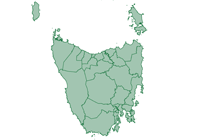Census employment data presents the number of persons employed in each industry sector (full-time and part-time) in Burnie City regardless of where they live. By comparing the number of jobs in each industry sector to a regional benchmark, you can clearly see local economic strengths and weaknesses. By looking at how the number of jobs in each industry is changing over time, you can track how the structure of the local economy is changing. Go to the Employment locations page to see where employment is taking place across Burnie City.
Note: Census employment figures are known to undercount employment by varying amounts depending on the Census year. All Census counts are an undercount of total population, and in addition, some people don’t state their workforce status or industry. Also counts by place of work exclude those with no fixed workplace address. For this reason, it is recommended that for total job numbers, users look at the Employment by industry (Total) modelled estimates which are updated on an annual basis, and based on the ABS Labour Force survey, less prone to undercount. The Census counts by industry are included here for a greater level of industry detail (3-digit ANZSIC).
Data source
Australian Bureau of Statistics (ABS) – Census 2016 & 2021 – by place of work
Current area:
Current benchmark:
| Employment (Census) by industry sector | |||||||||
|---|---|---|---|---|---|---|---|---|---|
| Burnie City | 2021 | 2016 | Change | ||||||
| Industry | Number | % | Tasmania | Number | % | Tasmania | 2016 - 2021 | ||
| Agriculture, Forestry and Fishing | 251 | 2.2 | 5.3 | 254 | 2.5 | 5.3 | -3 | ||
| Mining | 231 | 2.0 | 0.9 | 158 | 1.5 | 0.9 | +73 | ||
| Manufacturing | 734 | 6.4 | 6.4 | 768 | 7.5 | 6.9 | -34 | ||
| Electricity, Gas, Water and Waste Services | 62 | 0.5 | 1.8 | 61 | 0.6 | 1.6 | +1 | ||
| Construction | 568 | 4.9 | 8.6 | 536 | 5.2 | 7.6 | +32 | ||
| Wholesale Trade | 415 | 3.6 | 2.2 | 174 | 1.7 | 2.2 | +241 | ||
| Retail Trade | 1,330 | 11.5 | 9.7 | 1,298 | 12.6 | 10.9 | +32 | ||
| Accommodation and Food Services | 674 | 5.8 | 7.7 | 696 | 6.8 | 7.7 | -22 | ||
| Transport, Postal and Warehousing | 710 | 6.2 | 4.0 | 663 | 6.4 | 4.2 | +47 | ||
| Information Media and Telecommunications | 91 | 0.8 | 1.0 | 98 | 1.0 | 1.4 | -7 | ||
| Financial and Insurance Services | 210 | 1.8 | 1.8 | 187 | 1.8 | 2.1 | +23 | ||
| Rental, Hiring and Real Estate Services | 137 | 1.2 | 1.1 | 135 | 1.3 | 1.2 | +2 | ||
| Professional, Scientific and Technical Services | 345 | 3.0 | 4.9 | 306 | 3.0 | 4.7 | +39 | ||
| Administrative and Support Services | 243 | 2.1 | 2.9 | 479 | 4.6 | 3.0 | -236 | ||
| Public Administration and Safety | 840 | 7.3 | 7.3 | 837 | 8.1 | 7.8 | +3 | ||
| Education and Training | 1,175 | 10.2 | 9.5 | 970 | 9.4 | 9.3 | +205 | ||
| Health Care and Social Assistance | 2,627 | 22.8 | 16.5 | 1,850 | 18.0 | 14.2 | +777 | ||
| Arts and Recreation Services | 65 | 0.6 | 1.8 | 39 | 0.4 | 1.9 | +26 | ||
| Other Services | 502 | 4.4 | 3.8 | 457 | 4.4 | 3.8 | +45 | ||
| Industry not classified | 315 | 2.7 | 2.8 | 337 | 3.3 | 3.4 | -22 | ||
| Total persons | 11,527 | 100.0 | 100.0 | 10,303 | 100.0 | 100.0 | +1,224 | ||
Source: Australian Bureau of Statistics, Census of Population and Housing 2016 and 2021. Compiled and presented by .id (informed decisions). Please refer to specific data notes for more information | |||||||||


Dominant groups
An analysis of the jobs held by the local workers in Burnie City in 2021 shows the three most popular industry sectors were:
- Health Care and Social Assistance (2,627 people or 22.8%)
- Retail Trade (1,330 people or 11.5%)
- Education and Training (1,175 people or 10.2%)
In combination these three fields accounted for 5,132 people in total or 44.5% of the local workers.
In comparison, Tasmania employed 16.5% in Health Care and Social Assistance; 9.7% in Retail Trade and 9.5% in Education and Training.
The major differences between the jobs held by local workers of Burnie City and Tasmania were:
- A larger percentage of local workers employed in the field of Health Care and Social Assistance (22.8% compared to 16.5%)
- A smaller percentage of local workers employed in the field of Construction (4.9% compared to 8.6%)
- A smaller percentage of local workers employed in the field of Agriculture, Forestry and Fishing (2.2% compared to 5.3%)
- A larger percentage of local workers employed in the field of Transport, Postal and Warehousing (6.2% compared to 4.0%)
Emerging groups
The largest changes in the jobs held by local workers between 2016 and 2021 in Burnie City were for those employed in:
- Health Care and Social Assistance (+777 local workers)
- Wholesale Trade (+241 local workers)
- Administrative and Support Services (-236 local workers)
- Education and Training (+205 local workers)
